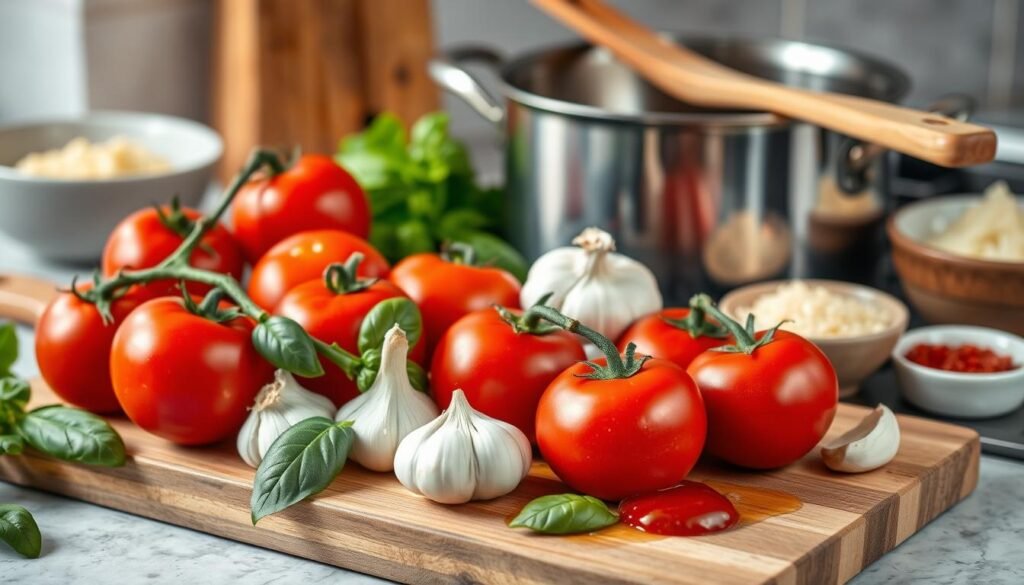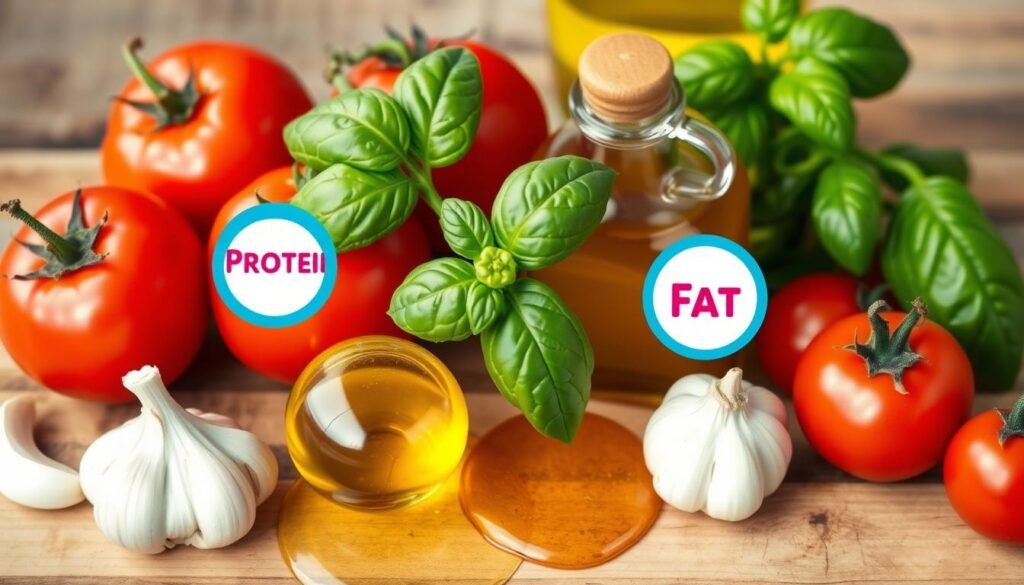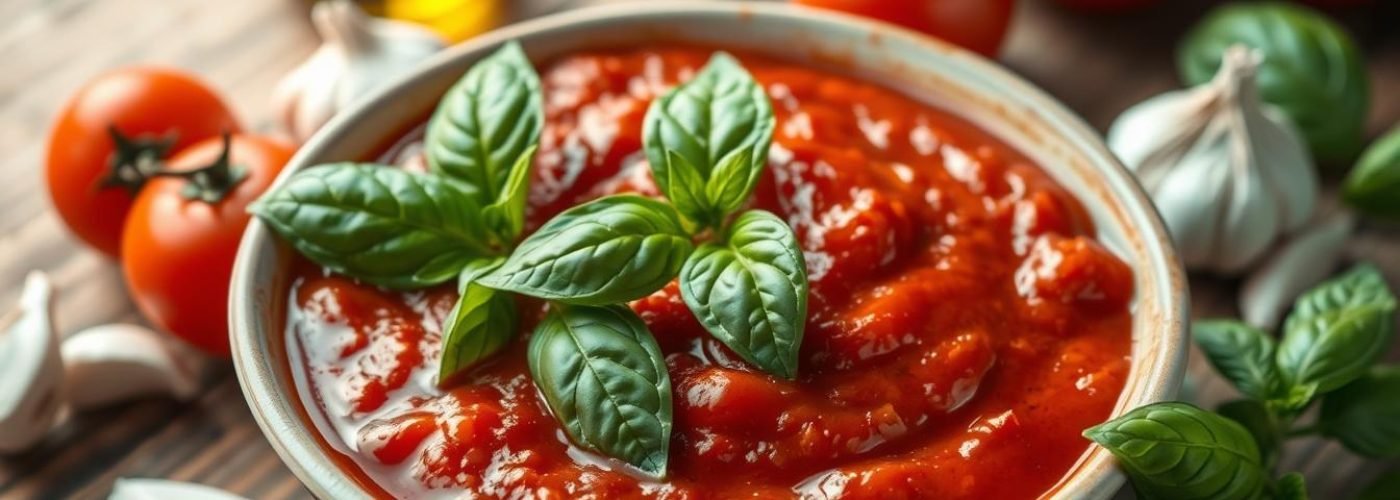If you’re in search of a delicious and healthy alternative to traditional sauces, look no further than this Low-Carb Marinara Recipe. Perfect for anyone following a low-carb or ketogenic diet, this Keto-Friendly Tomato Sauce is packed with fresh ingredients and robust flavors. With minimal carbohydrates, this homemade marinara offers a rich and satisfying experience that complements a variety of dishes, including pasta and pizza.
Introduction to Low-Carb Marinara Sauce
Low-Carb Marinara Sauce offers a delightful solution for those looking to enjoy a classic flavor while keeping their carbohydrate intake in check. Traditional marinara sauces often contain added sugars and higher carb content, making them less suitable for health-conscious individuals. Crafting your own Marinara Sauce Recipe allows for complete control over ingredients, promoting a Healthy Tomato Sauce that aligns with dietary preferences.
This homemade sauce not only enhances the taste of your meals but also supports Low-Carb Cooking. By using fresh tomatoes and herbs, you can whip up a rich and savory sauce that satisfies without straying from your dietary goals. Embracing the customization options ensures that every cook can tweak their sauce to match their palate, delivering a delicious experience for keto enthusiasts and casual diners alike.
Benefits of a Low-Carb Diet
A low-carb diet offers various advantages, making it a popular choice for those seeking to improve their health. Two significant benefits include enhanced weight management and better blood sugar control. By focusing on lower carbohydrate intake, individuals can experience notable changes in their overall well-being.
Improved Weight Management
Weight loss is often a primary goal for many adopting a low-carb diet. Reducing carbohydrate intake encourages the body to utilize stored fat for energy, which can lead to effective weight management. Notably, low-carb diets can help control hunger levels, leading to improved satiety and less frequent snacking. This combination fosters a sustainable approach to eating while supporting long-term weight loss goals.
Better Blood Sugar Control
Individuals with diabetes or insulin resistance may find enhanced blood sugar management through a low-carb diet. By minimizing carbs, spikes in blood sugar levels after meals can be effectively controlled. Research indicates that lower carbohydrate consumption improves insulin sensitivity, allowing the body to process sugar more efficiently. These factors contribute positively to overall health and well-being.
Key Ingredients for Low-Carb Marinara Sauce
Creating a delicious low-carb marinara sauce starts with selecting the right ingredients. Each component plays a crucial role in flavor and nutritional content. Here’s a breakdown of the key Marinara Sauce Ingredients that contribute to a mouthwatering and healthy dish.
Fresh Tomatoes and Tomato Paste
Fresh tomatoes are the cornerstone of any good marinara sauce. Their natural sweetness and high water content provide a rich flavor while keeping the carbohydrate count low. Additionally, tomato paste intensifies the sauce’s taste, offering a bolder flavor without significant carbs. Together, they create a balanced and tasty base for your sauce.
Herbs and Spices
Utilizing a variety of herbs and spices can elevate your marinara sauce without adding any carbohydrates. Essential herbs like basil and oregano along with seasonings such as garlic and onion powder deliver layers of flavor. These ingredients not only enhance taste but also promote a satisfying aroma that complements your meals.
Alternative Sweeteners
To balance the acidity of tomatoes without increasing carbohydrate levels, consider using low-carb sweeteners like erythritol or stevia. These alternatives provide sweetness without the sugar content, allowing you to maintain control over your carbohydrate intake while enjoying a flavorful sauce.
How to Make Low-Carb Marinara Sauce
Creating a delicious Low-Carb Marinara Sauce at home can elevate any meal. With simple steps, you’ll be able to craft a rich and flavorful sauce that follows the principles of a low-carb diet. Here are the Low-Carb Marinara Cooking Instructions to guide you through the process of making your own Homemade Marinara Recipe.
Step-by-Step Cooking Instructions
- Start by preparing fresh tomatoes. If using canned, select a high-quality brand without added sugars.
- Chop your tomatoes and place them in a pot over medium heat. If you’re using fresh tomatoes, consider peeling them for a smoother texture.
- Add minced garlic, chopped onion, and a pinch of salt. These ingredients will enhance the sauce’s flavor.
- Incorporate Italian herbs like basil, oregano, and thyme to the mixture for authentic taste.
- Simmer the sauce for about 30-45 minutes, stirring occasionally. This allows the flavors to meld beautifully.
- If desired, add a low-carb sweetener, such as stevia or erythritol, to balance the acidity.
- For a smoother consistency, blend the sauce with an immersion blender or let it cool slightly before transferring it to a regular blender.
- Adjust seasoning to taste and let it simmer for a few more minutes if necessary.
Preparation Tips
- Using ripe, high-quality tomatoes will significantly enhance the flavor of your sauce.
- Control the salt and sugar levels for a healthier option; avoid adding too much.
- For added depth, consider slow-roasting your tomatoes before adding them to the pot.
- Prepare a larger batch and freeze portions for convenient future meals.
- Experiment with different herbs and spices to find your preferred flavor profile.

Making a Homemade Marinara Recipe is not only straightforward but allows for personal preferences and adjustments. Enjoy the process and savor the results in your favorite low-carb dishes!
Cooking Techniques to Enhance Flavor
Understanding the right cooking techniques can significantly enhance the flavor of Low-Carb Marinara Sauce. Two primary methods display distinct benefits: slow cooking and rapid cooking. Both approaches bring unique advantages that affect taste, texture, and aroma. Equally important is how herb usage varies between fresh and dried varieties, with each offering different flavor profiles. Let’s explore these techniques to elevate your marinara experience.
Slow Cooking vs. Quick Cooking
Slow cooking allows the ingredients to intermingle over a longer period, leading to flavor enhancement that can transform a dish. The gradual process develops deeper, richer flavors, perfect for a marinara sauce that benefits from time to blend its components. Ingredients meld harmoniously, creating a robust flavor that quick cooking might not achieve.
On the other hand, quick cooking techniques tend to optimize freshness, vital for retaining the natural brightness of tomatoes and herbs. The challenge lies in balancing speed with flavor, but skillful use of heat can still yield a delightful sauce with a fresh and immediate taste. Choosing the right method relies on the desired outcome for your Low-Carb Marinara Sauce.
Using Fresh vs. Dried Herbs
Herb usage plays a pivotal role in defining the essence of any marinara sauce. Fresh herbs, like basil and parsley, deliver a vibrant, aromatic freshness that infuses dishes with life. Their essential oils contribute a fragrant note that brightens the sauce.
Dried herbs, while more concentrated, offer a different touch. They are time-released flavor enhancers that bring depth. When used in moderation, they can provide a strong, savory backdrop, making them a fantastic alternative for those busy culinary moments or when fresh options are unavailable.
Ultimately, experimenting with both fresh and dried herbs allows chefs to uncover layers of flavor, enhancing the dish’s profile whether slow-cooked or prepared quickly.
Ideal Dishes to Pair with Low-Carb Marinara Sauce
Low-Carb Marinara Sauce shines as a versatile condiment that enhances various dishes. From keto-friendly pasta alternatives to delicious pizza toppings, there’s no shortage of ways to enjoy this flavorful sauce.
Keto Pasta Alternatives
For those following a low-carb diet, traditional pasta can pose a challenge. Fortunately, several alternatives allow for satisfying dishes with marinara sauce:
- Zucchini Noodles: Spiralized zucchini provides a fresh and light base that pairs beautifully with marinara.
- Spaghetti Squash: When roasted, this squash forms strands that mimic pasta, creating a hearty delivery for the sauce.
- Konjac Noodles: These zero-calorie noodles can absorb the flavors of the marinara and make a filling meal.
These keto pasta alternatives can transform any dinner into a pasta night while keeping the carb count low. The combinations create delightful dishes with marinara sauce that are both satisfying and healthy.
Using Sauce on Pizza
Homemade low-carb pizza opportunities abound with low-carb marinara sauce. The sauce acts as a foundational layer, complementing various toppings:
- Cauliflower Crust: A popular choice for those wanting to keep it low-carb yet delicious.
- Portobello Mushrooms: Large mushrooms serve as an excellent pizza base, offering a unique twist on pizza night.
- Cheese Crust: Incorporating cheese into the crust provides a satisfying, cheesy experience while maintaining low carbs.
Enhancing any pizza topping with a generous layer of low-carb marinara sauce not only boosts flavor but also adds to the enjoyment of creating delicious meals. The combination creates unforgettable dishes with marinara sauce that family and friends will love.
Storage Tips for Marinara Sauce
Proper Marinara Sauce Storage ensures that your delicious low-carb marinara remains flavorful and fresh. With the right techniques, you can make the most of your sauce, whether saving it for later or reheating it for immediate enjoyment.
Freezing Marinara Sauce
Freezing is an excellent way to keep your homemade low-carb marinara sauce for extended periods. Follow these Freezing Tips to maintain the taste and texture:
- Allow the sauce to cool completely before freezing.
- Portion out the sauce into serving-sized containers, making meal preparation easier.
- Use airtight containers or freezer bags to prevent freezer burn.
- Label containers with the date to keep track of freshness.
Reheating for Best Flavor
To ensure that your sauce tastes just as good upon reheating, consider these Reheating Methods:
- Thaw the sauce overnight in the refrigerator for optimal results.
- Heat in a saucepan over medium-low heat, stirring often to maintain an even temperature.
- Microwaving is quick; use a microwave-safe container and heat in short intervals, stirring in between.
- Adding a splash of water or broth can help restore the sauce’s original consistency if it thickens during freezing.
| Storage Method | Duration | Reheating Method |
|---|---|---|
| Refrigerator | 3-5 days | Stovetop or Microwave |
| Freezer | Up to 3 months | Thaw in Refrigerator & Stovetop |
With these tips, you can confidently enjoy your low-carb marinara sauce without worrying about freshness or quality. Proper Marinara Sauce Storage and effective reheating will ensure every bite is as satisfying as the first.
Macronutrient Breakdown of Low-Carb Marinara Sauce
Understanding the macronutrient composition of Low-Carb Marinara Sauce is essential for anyone following a low-carb diet. This section will provide detailed nutritional information, emphasizing how this sauce can fit into your dietary goals while delivering a delicious flavor. The breakdown covers calories per serving along with carbohydrate, fat, and protein content, providing a clear comparison to traditional sauces.
Calories per Serving
A typical serving of Healthy Marinara contains approximately 50 calories. This makes it an ideal choice for those mindful of their caloric intake. By opting for this low-carb sauce, you can enjoy a flavorful addition to your meals without feeling guilty about excess calories.
Carbohydrates, Fats, and Proteins
The macronutrient composition of Low-Carb Marinara Sauce reveals its benefits:
- Carbohydrates: Approximately 5 grams per serving, significantly lower than traditional marinara, allowing for better compliance with low-carb dietary requirements.
- Fats: Around 2 grams per serving, contributing to satiety without overwhelming your daily fat intake.
- Proteins: Contains 1 gram per serving, offering a small boost that complements other protein sources in your meal.
This favorable macronutrient breakdown aligns perfectly with low-carb dietary goals, making it a superb alternative to conventional marinara sauces.

Making it Your Own: Customization Ideas
Personalizing your Low-Carb Marinara Sauce allows for a culinary experience tailored to your taste preferences and dietary needs. Through Marinara Sauce Customization, adding your favorite protein sources and incorporating vegetables can elevate both nutrition and flavor. Explore creative options that enhance your dinner plate.
Adding Protein Sources
Including protein in your marinara can transform a simple dish into a hearty meal. Consider the following options for Adding Protein:
- Ground turkey: A lean alternative that blends well with the sauce.
- Ground beef or sausage: Choose spicy or mild varieties to match your flavor preference.
- Shredded chicken: Ideal for a lighter, yet satisfying option.
- Plant-based proteins: Options like lentils or chickpeas work well for vegetarian dishes.
Experimenting with Vegetables
Vegetable Ideas not only enhance the nutritional value of your marinara but also add texture and flavor. Try these options for a more vibrant sauce:
- Mushrooms: They give a rich, earthy flavor and meaty texture.
- Bell peppers: Sweet and colorful, they brighten your dish while providing crunch.
- Spinach or kale: These leafy greens boost vitamins and minerals.
- Zucchini: Spiralized or diced, zucchini adds volume without many carbs.
By blending these ingredients into your Low-Carb Marinara Sauce, you create a unique dish that reflects your personal taste. Embrace the flexibility of Marinara Sauce Customization to create something extraordinary!
Common Mistakes to Avoid When Making Marinara Sauce
Creating a delicious marinara sauce can be a rewarding experience, but there are common Marinara Sauce Mistakes that can compromise the final product. One significant pitfall involves overcooking the sauce. Prolonged cooking can lead to a loss of flavor and a mushy texture. Aim for a gentle simmer to preserve the freshness of the ingredients.
Another frequent error is under-seasoning. Marinara sauce requires a careful balance of herbs and spices. Failing to season properly can result in a bland sauce that lacks depth. Utilizing recipe tips such as tasting along the way can help achieve a well-rounded flavor profile.
Quality of ingredients plays a vital role as well. Using canned tomatoes that are overly acidic or of poor quality can lead to unbalanced flavors. Opting for high-quality tomatoes can make a world of difference. Excessive sugar is another common mistake. While it may seem like a good way to balance acidity, most marinara should rely on its natural sweetness from the tomatoes.
Ensuring a balanced flavor involves understanding the ingredients. Taking a little time to select fresh herbs and spices can minimize cooking errors and elevate the dish. By being mindful of these pitfalls, home cooks can create a flavorful marinara sauce that stands out.
Why Homemade Marinara is Better Than Store-Bought
The Benefits of Homemade Sauce are numerous when compared to their store-bought counterparts. Making marinara sauce at home allows for complete control over the ingredients. This means you can opt for high-quality fresh tomatoes, organic herbs, and avoid unnecessary preservatives typically found in store-bought options.
Another significant advantage is the ability to tailor flavors to your preferences. Want an extra kick of garlic or a hint of sweetness? Homemade marinara lets you customize your sauce precisely to your taste. In contrast, store-bought sauce often comes with a pre-defined profile that may not satisfy everyone.
When considering health aspects, homemade sauces generally have less sugar and fewer unhealthy fats. Many store-bought options can contain excessive amounts of sugar and preservatives, raising health concerns. The Store-Bought Sauce Comparison highlights these discrepancies effectively.
Finally, there is a rewarding experience in cooking your own sauce. The aroma of simmering tomatoes and spices fills your kitchen, offering a sense of accomplishment that pre-packaged sauces can’t match. Embrace the freshness of your own marinara, knowing that each ingredient has been meticulously selected by you for the best flavor and health benefits.
| Feature | Homemade Marinara | Store-Bought Marinara |
|---|---|---|
| Control Over Ingredients | Full control of quality and type | Often contains preservatives and additives |
| Customization | Tailored to individual taste | Standard flavor profile |
| Sugar Content | Minimal, can be adjusted | Often high in sugar |
| Freshness | Made with fresh ingredients | May use canned or processed ingredients |
| Cooking Experience | Engaging and rewarding | Less engaging |
Final Thoughts on Low-Carb Marinara Sauce
Incorporating Low-Carb Marinara Sauce into your meals not only elevates flavor but also supports a healthier lifestyle. This homemade sauce exemplifies a perfect blend of fresh ingredients and wholesome nutrition, showcasing a summary of marinara sauce benefits that can significantly enhance your daily menu. By embracing healthy cooking techniques, you’ll not only delight your taste buds but also make a thoughtful choice for your dietary goals.
Exploring your culinary creativity is made easier with this versatile sauce. Whether paired with keto-friendly pasta or drizzled over veggies, the possibilities are endless. This adaptability invites you to experiment and customize your marinara, turning each meal into a flavorful experience while maintaining a focus on nutritional value. Each serving can be a reminder that cooking at home can contribute to your well-being.
Ultimately, choosing to make your own Low-Carb Marinara Sauce is a step towards a healthier diet. By focusing on its key ingredients and cooking methods, you can enjoy a homemade masterpiece that’s both satisfying and beneficial for your body. So, grab those fresh tomatoes and spices, and start cooking—your body will thank you for it!

